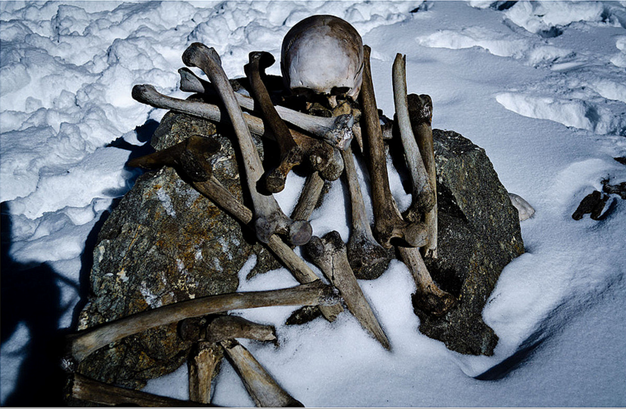
Photo Courtesy : indiahikes
Roopkund is locally known as Skeletons Lake or Mystery Lake. Having a depth of 3 meters, Roopkund and is widely known for hundreds of ancient human skeletons that are found at the edge of the lake. The human skeletons can be seen at its bottom when the snow melts. Research generally points out that something semi-legendary happened that such a great number of people died. Because of the human remains, the lake is called Skeleton Lake.
Roopkund is a high altitude glacial lake in Chamoli, Uttarakhand state of India. It lies in the Trishul massif. The lake is located in the Himalayas and is uninhabited, it is situated roughly at an altitude of 16470 feet, surrounded by rock-strewn glaciers and snow-clad mountains. It is a popular trekking destination.
Hari Krishnan Madhawal, a Nanda Devi reserve game ranger rediscovered the bones in 1942, although records about these bones are from the late ninth century. In the beginning, British officials feared that the skeletons represented victims of a hidden Japanese invasion force, the skeletons were too ancient to be of Japanese soldiers.
The skeletons are visible in the pure water of the shallow lake during a one – month period when the snow melts. Along with the skeletons, wooden artifacts, iron spearheads, leather slippers, and rings were also discovered.
When a team from National Geographic Magazine retrieved about 30 skeletons, the flesh was still attached to them. Later studies placed the time of mass death around the ninth century CE and the second group of skeletons was dated to the nineteenth century CE.
According to locals the King of Kanauj, Raja Jasdhaval, among his pregnant wife, Rani Balampa, their helpers, a masquerade troupe, and others went on a pilgrimage toward Nanda Devi shrine and the group suffered a hurricane with large hailstones, from which the whole party died near Roopkund Lake.
Remnants belonging to more than 300 people have been found. Radiocarbon dating of the bones at Oxford University’s Radiocarbon Accelerator Unit determined the period to be 850 CE. The Anthropological Survey of India directed a study of the skeletons during while the 1950s and some specimens are illustrated at the Anthropological Survey of India Museum, Dehradun.
Most recently, Radiocarbon dating found that the remains are from different eras. All of the remains with South Asian ancestry were dated to about 800 CE while the other skeletal remains examined were dated to about 1800 CE. “These conclusions contradict earlier suggestions that the skeletons of Roopkund Lake were deposited in a particular catastrophic event,” the scientists describe, in Nature Communications.
Genome-wide DNA research of skeletons from Harney declared that the skeletons were related to two different groups; one group is composed of individuals with broadly South – Asian related ancestry from ninth CE, and the second group is composed of individuals from 200 years ago with genetic affinity with East Mediterranean.
The studies of the skeletons exposed a common reason of death: blows to the back of the head, caused by round things falling from above. The researchers terminated that the victims had been caught in an immediate hailstorm, just as defined in the local myths and songs.
In a study issued in August 2019, the DNA derived from 38 skeletons was examined and reported that many diverse populations felt mortal occurrences at the lake, departed in time by approximately 1000 years, and one that occurred as late as the nineteenth century.
There is a growing concern about the regular loss of the skeletons and it is feared that, if steps are not taken to conserve them, the skeletons may gradually vanish in the years to come. It is reported that tourists visiting the area are in the habit of taking back the bones in large numbers and the district has expressed the need to protect the area. The area judge of Chamoli District has stated that visitors, trekkers, and interested researchers are carrying the skeletons on mules and advised that the area should be preserved. Governmental agencies have made efforts to develop the area as an ecotourism destination to protect the skeletons.
Roopkund is a charming tourist target and one of the most significant areas for trekking in Chamoli District, Himalayas, near the foot of two Himalayan hills: Trishul and Nanda Ghunti. The lake is flanked by a rock appearance named Junargali to the North and a hill named Chandania Kot to the East. A divine festival is held at the alpine meadow of Bedni Bugyal every autumn with nearby communities participating. A lavish celebration, the Nanda Devi Raj Jat, takes place once every twelve years at Roopkund, throughout which Goddess Nanda is admired.
Roopkund Lake is coated with ice for the maximum time of the year. The best time to trek is in the autumn which is from mid-September to October.
India is the birthplace of many such mysteries some of them are, The Twin Town in Kerala, The Lifting Stone, Door – less Houses, and several more which are still to be resolved!
By Shruti Singh


